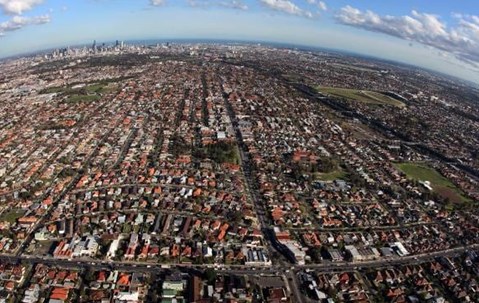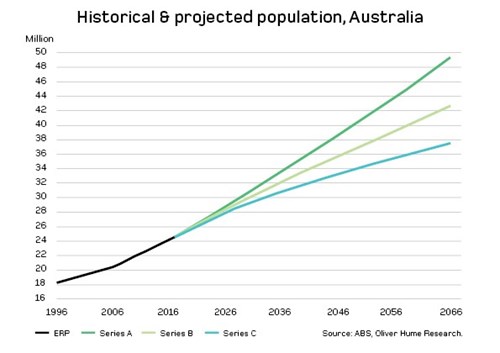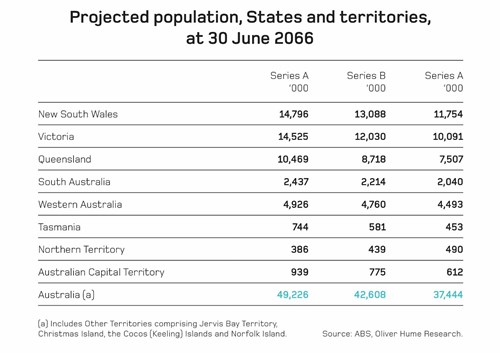News & Tips

Australia’s growing population underpins the property market
February 22, 2019
George Bougias
National Head of Research, Oliver Hume
2018 was an important year for the residential property market. The moderation in Australia’s largest property markets of Sydney and Melbourne, especially, provided a timely reminder that, like the economic cycle, the property cycle is as inevitable as the setting sun.
The year also provided a reminder that while the fundamentals of supply and demand still drive the property market, in the short and medium term, human emotion and market sentiment can exacerbate the natural ups and downs of the cycle.
An opportunity to refocus
The beginning of a new year provides the opportunity to reflect on the year just gone and think about the future. More specifically, this is perhaps the best time to think beyond short-term volatility and more about the medium and long-term future and health of the market which will be shaped, ultimately, by the underlying fundamentals of the property market.
Of all the factors that drive the supply and demand for property, population stands alone for its degree of influence. An invaluable and timely resource in this regard is the Australian Bureau of Statistics’ (ABS) most recent population projections (released in November 2018).
The population projections, which cover the period 2018 to 2066, contain several important insights.
This is because residential real estate is a long-term game, including especially for ‘buy and hold’ investors, and identifying and understanding current and emerging trends in population is one of the keys ways you can capitalise on strategic shifts in the market and capitalise on major opportunities.
The ABS projections are based on different assumptions about the future levels of fertility, mortality, overseas migration and internal migration.
The projections provide some important takeaways that anyone interested in property should know and understand.
Growth
Under a range of scenarios, Australia's estimated resident population (ERP) of over 24.6 million people (as at June 2017) could reach 30 million in 11 to 15 years (between the years 2029 and 2033). A further 10 million people (or approximately the equivalent of two cities the size of Melbourne) could be added to Australia’s population in the following decade (to 2043).
Further ahead, Australia's estimated resident population could grow to between 37 million and 49 million people by 2066. In the latter scenario this could mean Australia’s population almost doubles within the next half century.

Population growth is expected to remain generally strong in the medium and high growth scenarios modelled by the ABS while growth in the other scenario is still expected to remain stable. Population growth rates and key sources of population of growth are expected to differ over the various future periods.
For example, in the decade to June 2027, Australia's population is projected to increase by between 1.4%, 1.6% or 1.8% per annum. This compares to the 1.7% per annum growth in the decade to June 2017.
States and territories
New South Wales is expected to remain Australia’s largest state reaching a population of 10 million as early as 2033 potentially. By 2066 the population of NSW could reach almost 15 million people.
However, continuing recent trends, Victoria is expected to have the largest and fastest population increase. Under one scenario, Victoria's population (currently around 6.3 million people) could more than double by 2066 (growing faster than the national average) to exceed 14.5 million.
Queensland’s population could increase by 1 million people from June 2017 to reach 5.9 million people by 2027. By 2066 Queensland’s population could reach almost 10.5 million people.

Urbanisation
Australia’s population is expected to be increasingly urbanised and the share of Australians living in capital cities could increase, over the medium-term, from 67% (2017) to 70% (2027).
The urbanisation trend is expected to be observed in all jurisdictions. For example, Melbourne’s share of Victoria’s population could increase from 77% in 2017 to 85% in 2066.
Melbourne to be Australia’s largest city
Australia’s largest city could be Melbourne with the city’s population potentially exceeding that of Sydney, potentially, by 2031.
By 2066 Melbourne could have a population of between 12.2 million (more than double the current population) and 8.6 million people.
Sydney’s population could increase from 5.1 million (June 2017) to 11.2 million by 2066.
Outlook and Considerations
Despite the overwhelming short-term focus of the media and the constant demands for day to day analysis, it is important to remember that property is a long-term game.
While population projections and forecasts are never likely to be perfect, the ABS population projections are one of the best tools for seeing over the horizon into Australia’s future and understanding what may occur under different assumptions and scenarios.
So, what do the projections tell us?
In a nutshell, Australia is likely to continue enjoying stable, if not robust, population growth.
Overseas migration is likely to continue to play an important role in driving our population growth.
Our cities and towns will continue to experience the highest level of population growth as urbanisation, now a truly global phenomenon, also shapes our nation.
Above all, Australia’s population growth is likely to remain the key driver of our property markets creating many future opportunities.

